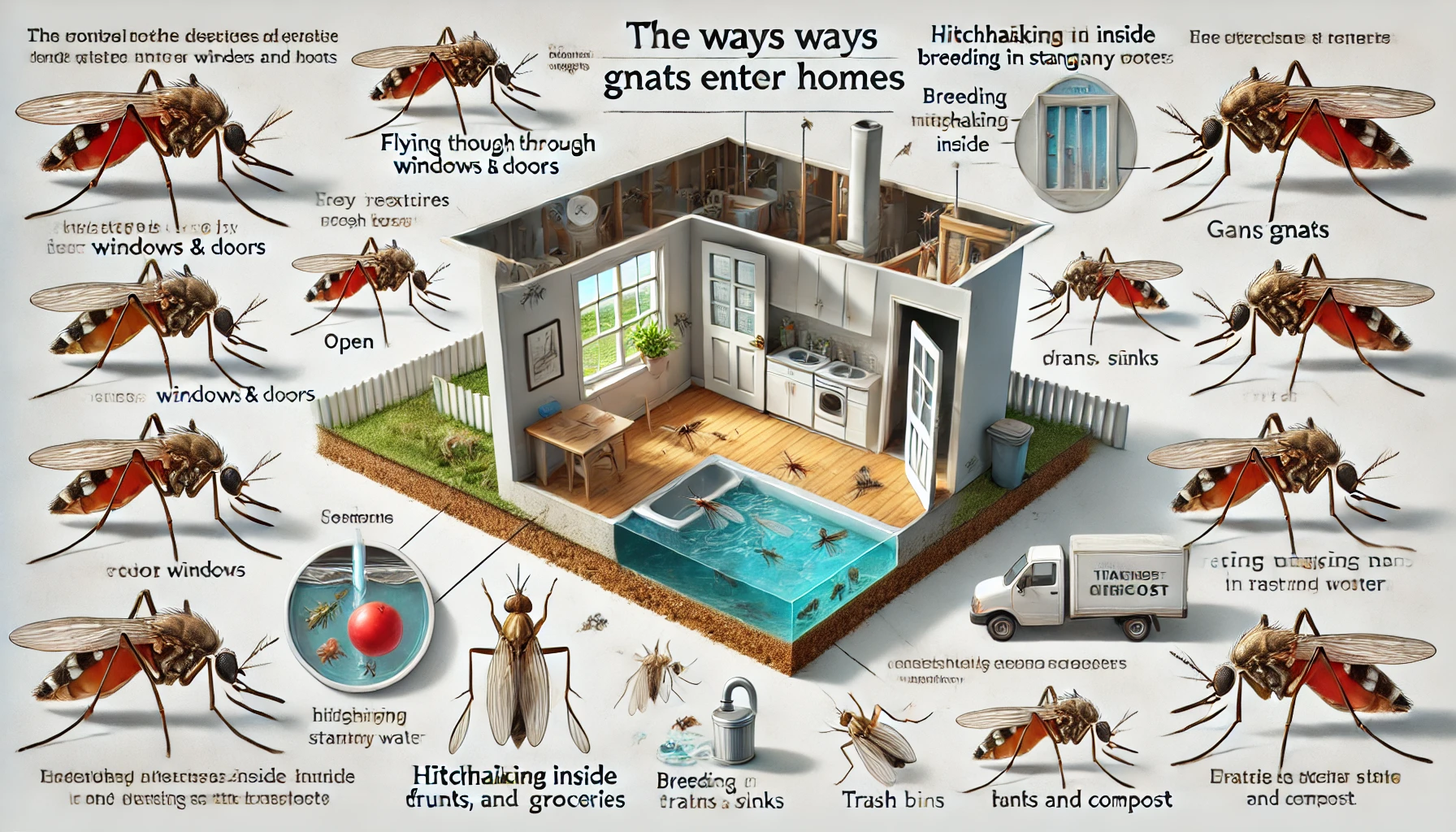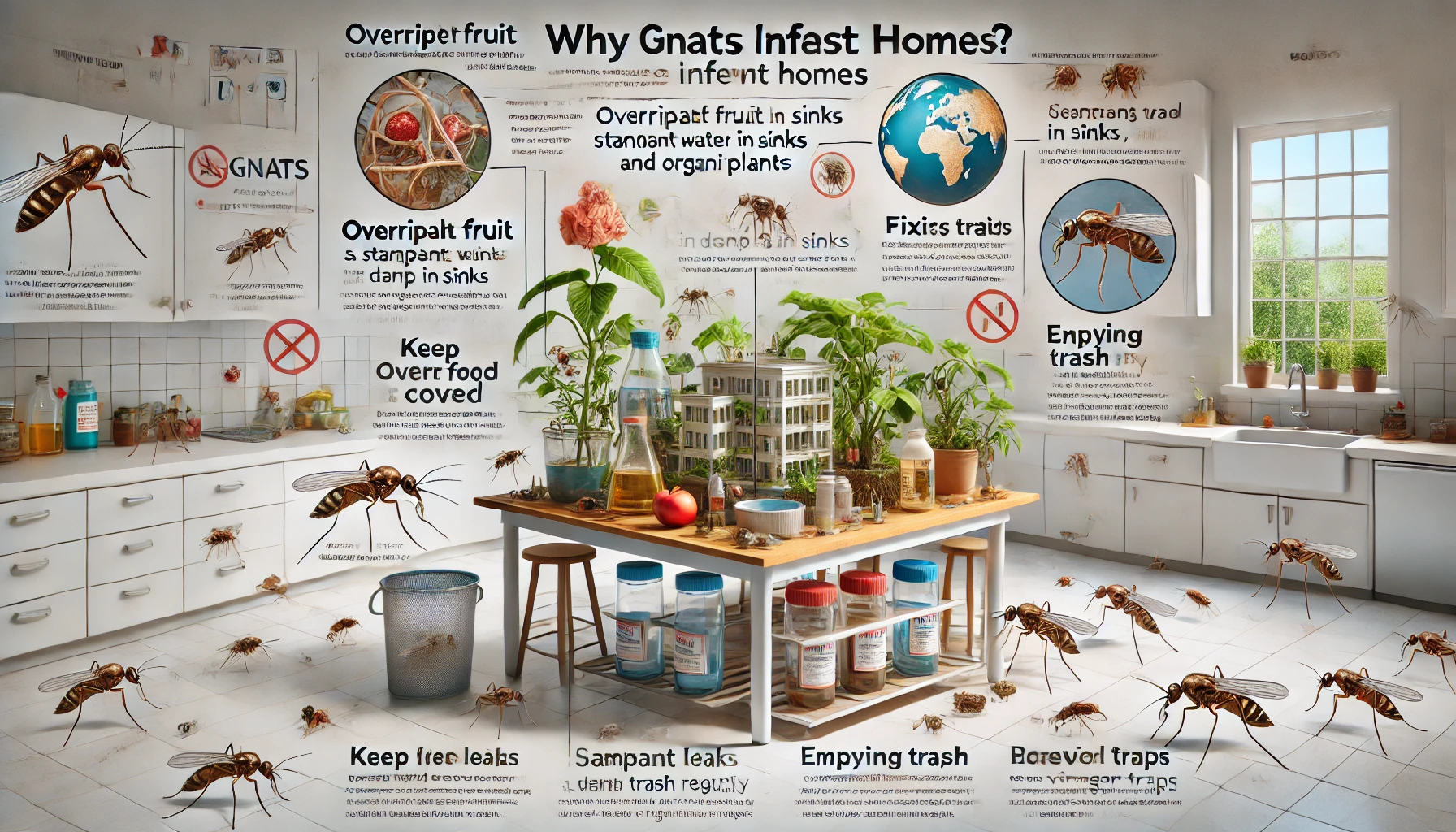Key Takeaways
- Gnats enter homes through open doors, windows, damaged screens, grocery items, plants, and drains.
- Moisture, organic material, and food sources inside homes attract gnats.
- Regular home maintenance, proper waste management, and plant care help prevent infestations.
- Reducing indoor humidity and sealing entry points effectively keep gnats out.
- Professional pest control services offer comprehensive solutions for persistent infestations.
This detailed guide explores the primary ways gnats infiltrate households across the United States and provides action taking information to keep these pests at bay.

Ways Gnats Enter Homes
Gnats can discover into your homes through various ways. Knowing these entry points can help you implement effective preventative measures. 1. Open Doors and Windows One of the simplest ways gnats enter your home is through open doors and windows. During warmer months, homeowners frequently open windows and doors to allow fresh air to circulate, unintentionally inviting gnats inside. These tiny pests are attracted to light and moisture, so open entryways at dawn and dusk significantly increase the risk of infestation. 2. Damaged Screens and Vents Even when doors and windows remain closed, gnats can enter through small tears or holes in window screens or vents. Damaged or improperly fitted screens fail to serve as an effective barrier, giving gnats easy access into your home. Regular inspection and repair of screens and vent covers are essential preventive steps. 3. Houseplants and Potting Soil Houseplants are frequent sources of indoor gnat infestations, particularly fungus gnats. These pests lay eggs in moist potting soil, and larvae feed on organic material and plant roots.When you purchase plants or soil, gnats and their eggs may already be present. Once inside your home, the larvae develop, creating an ongoing infestation issue. 4. Grocery Items and Produce Fruit flies, a common type of gnat, often enter homes via fruits and vegetables bought from grocery stores. Tiny eggs and larvae attached to produce surfaces quickly hatch and mature, particularly when stored at room temperature. Overripe fruits, vegetables, and other perishable items become breeding grounds, resulting in a rapid increase in gnat populations. 5. Drain Systems and Plumbing Drain gnats, also known as drain flies, enter homes through plumbing systems. They breed in the damp organic material that builds up in drains, pipes, and garbage disposals. Gnats find their way into homes via sewer lines and plumbing networks, appearing near sinks, showers, and toilets, especially when plumbing maintenance is overlooked. 6. Trash and Recycling Bins Improperly managed trash and recycling bins frequently attract gnats. Decaying organic matter in these bins serves as a primary breeding site. If your bins lack secure lids or are not regularly cleaned, gnats will quickly infest and spread throughout your home. 7. Pets and Pet Areas Gnats can enter homes through pets, their bedding, or pet food. Pets that spend their time outdoors without any information can help transport gnats or their larvae indoors. Additionally, pet food bowls left out overnight, particularly wet food, attract gnats seeking moisture and nourishment.


Not getting a solution?
Get your free pest control estimate today!- Moisture and Humidity
- Organic Matter and Food Sources
- Warmth and Shelter

Preventative Measures to Stop Gnats from Entering Your Home
To effectively and efficiently prevent gnats from entering and infesting your home, follow these proactive measures:Regular Maintenance and Repairs
-
Inspect and repair window and door screens regularly to eliminate entry points.
-
Seal gaps around doors, windows, vents, and pipes to prevent gnats from sneaking indoors.
-
Maintain plumbing and promptly address leaks and drainage issues to remove breeding grounds.
Proper Plant Care
-
Inspect houseplants thoroughly before purchasing or bringing them indoors.
-
Allow the topsoil to dry out between waterings to discourage fungus gnat breeding.
-
Consider repotting plants with sterile soil if infestations persist.
Responsible Food Storage
-
Store your fruits and vegetables in the refrigerator, cold storage, or covered containers to prevent attracting fruit flies.
-
Regularly dispose of overripe or spoiled produce promptly.
-
Clean kitchen surfaces frequently to eliminate food residue.
Effective Waste Management
-
Use bins with secure lids for both trash and recycling to limit access.
-
Regularly clean bins with soap, water, and disinfectants to remove potential attractants.
-
Avoid leaving garbage in your home for extended periods.
Manage Moisture and Humidity
-
Use dehumidifiers and ventilation systems to maintain indoor humidity below 50%.
-
Regularly dry areas around sinks, showers, and laundry rooms to reduce moisture.
-
Promptly address leaks or standing water to eliminate breeding grounds.
Pet Hygiene and Management
-
Regularly groom pets and check for pests before allowing them indoors.
-
Clean pet bedding frequently, and avoid leaving food bowls out overnight.
-
Store pet food in airtight containers.
Use Gnat Deterrents
-
Place traps, such as sticky fly strips or apple cider vinegar traps, in problem areas to monitor and manage populations.
-
Utilize essential oils like citronella, lavender, or eucalyptus to naturally repel gnats.

Professional Pest Control Solutions
In the cases of severe or constant gnat infestations, professional pest control services center or company can provide with detailed treatments that target gnats at all lifecycle stages. Experts have proper expertise which help them quickly identify breeding sites and apply effective solutions tailored to your specific situation, providing both immediate relief and long-term prevention.With the help of understanding the ways gnats enter homes and puthing these comprehensive methods into action, you can significantly reduce possible future infestations and maintain a comfortable, pest-free environment for your household.
If you feel things have gone out of control, it is advised to contact pest control professionals. Our team can provide a customized approach to protect your home effectively.
Visit our Species, Control, and DIY Guide sections for additional resources on gnats and ways to tackle a gnats infestation.





